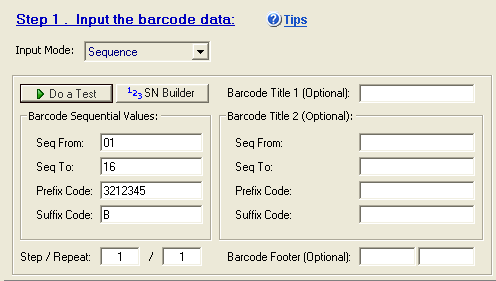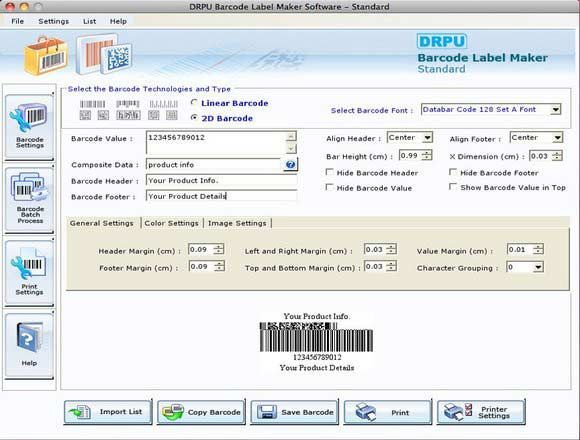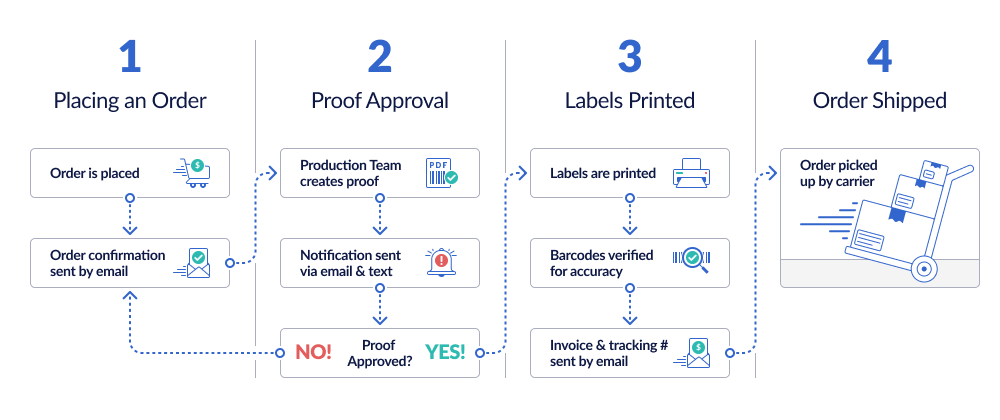

- #Creating a sequential barcode label with label matrix 7 code#
- #Creating a sequential barcode label with label matrix 7 series#
Create a printer barcode for the newly created system barcode with appropriate print control:įor creating a system barcode go to transaction SE73.Then save the changes by clicking on the Ok button. Also specify the height and width of the barcode. For barcode type enter ‘UNDEF’ ( barcode not defined) as the data matrixīarcode type is not defined in SAP.

#Creating a sequential barcode label with label matrix 7 code#
The Create/Change System Bar Code settings screen will be displayed. Of barcodes symbologies to be created therefore we are going to use Old technology to create our new barcode as an undefined symbology. The barcode we are adding is a new barcode symbology which is not supported by SAP, and the new barcode techcnology allows only specif types The Choose Bar Code Technology select box will now be displayed.

This will display a list of all the Barcodes on the SAP system.Ĭlick the Create button (Paper icon) at the top of the screen Select System barcodes check box and click the change button. This will take you to the SAP script Font Maintenance: Initial screen
Create a system barcode of type UNDEF in SAP: For creating a system barcode go to transaction SE73. #Creating a sequential barcode label with label matrix 7 series#
For Zebra printers we have the following device types LZEB* (* => 2/3/4) series or YZB# (# => 200/300/400) series based on the DPI resolution of the printer.įor the demonstration as an example we will use LZEB2 device type from here on in this document. In this example we are using ZEBRA printer so the device type selction will be based on Zebra printer.This topic is dealt in more detail in the other document named ‘ Working with Zebra Printers using Smartforms in SAP’ please refer to the same for additional documentation on selecting the device type for Zebra printers.
 Choose an appropriate device type for the printer: Selection of device type is based on the printer you are using. Most probably you will find this information on the manufacturer’s website. Printer should support the required barcode: We can check this online based on the printer model and make. Printing other 2D barcodes which are not supported by SAP is possible by following the below steps SAP by default only supports PDF417 as 2D barcode and does not support Data Matrix and other 2D barcodes * Similar approach can be followed for printing other 2D barcodes and the generic barcodes with specific height and width. Print Data Matrix barcode (2D barcode) on zebra printers using Smartform. As a result of that construction, 2D codes can store up to 7,089 characters and possibly more.īelow are some of the types of 2D barcodes The numerical code is read using a reading device.In this document we will work on printing a Data Matrix barcode (DMC) which is a 2D barcode not supported by SAP.Ī 2D (two-dimensional) barcode is a graphical image that stores information both horizontally - as one-dimensional bar codes do - and vertically. This tiny computer chip with an antenna is applied to various objects and contains a numerical code, such as the electronic product code (EPC, see entry). The core of RFID technology is an RFID transponder. RFID is a technology for contactless data transmission on the physical basis of electromagnetic alternating fields, i.e. Number of labels on a sheet or printing plate Is reduced by dust and dirt – can be reused many times You can clean the adhesive side easily with water, if adhesion adhesion. Without glue thanks micro suction structure Name for how two different materials stick together or for the interaction of the adhesive with the substrate to be adhered to. Sticks easily, without bubbles or creases. Sticks without adhesive to all flat, clean surfaces Under surface printing makes these labels extremely scratch-proof and resistant to oils and weak chemicals. Using these additional colour features can make label identification even easier. Of 800 dpi, we can represent photographic quality images. In code pens, distance scanners and slot readers, the optical resolution (related to a standard distance), can be for example 0.15 mm, 0.25 mm or 0.38 mm In scanners, however, resolution (known as optical resolution) is a parameter for the readability of a barcode. Printer resolution is measured in dpi and can be different in the X and Y directions, depending on the type of printer. With our state of the art presses we can print unlimited colours and fonts.Ī parameter which shows how many points can be created on a specific area. item numbers) using a system of bars, suitable to be read directly into a computer. Using the latest digital printing technology with our new ‘hp indigo’ presses, we have been able to revolutionise the new design options for sequential barcode barcodeĭepiction of numbers (e.g.
Choose an appropriate device type for the printer: Selection of device type is based on the printer you are using. Most probably you will find this information on the manufacturer’s website. Printer should support the required barcode: We can check this online based on the printer model and make. Printing other 2D barcodes which are not supported by SAP is possible by following the below steps SAP by default only supports PDF417 as 2D barcode and does not support Data Matrix and other 2D barcodes * Similar approach can be followed for printing other 2D barcodes and the generic barcodes with specific height and width. Print Data Matrix barcode (2D barcode) on zebra printers using Smartform. As a result of that construction, 2D codes can store up to 7,089 characters and possibly more.īelow are some of the types of 2D barcodes The numerical code is read using a reading device.In this document we will work on printing a Data Matrix barcode (DMC) which is a 2D barcode not supported by SAP.Ī 2D (two-dimensional) barcode is a graphical image that stores information both horizontally - as one-dimensional bar codes do - and vertically. This tiny computer chip with an antenna is applied to various objects and contains a numerical code, such as the electronic product code (EPC, see entry). The core of RFID technology is an RFID transponder. RFID is a technology for contactless data transmission on the physical basis of electromagnetic alternating fields, i.e. Number of labels on a sheet or printing plate Is reduced by dust and dirt – can be reused many times You can clean the adhesive side easily with water, if adhesion adhesion. Without glue thanks micro suction structure Name for how two different materials stick together or for the interaction of the adhesive with the substrate to be adhered to. Sticks easily, without bubbles or creases. Sticks without adhesive to all flat, clean surfaces Under surface printing makes these labels extremely scratch-proof and resistant to oils and weak chemicals. Using these additional colour features can make label identification even easier. Of 800 dpi, we can represent photographic quality images. In code pens, distance scanners and slot readers, the optical resolution (related to a standard distance), can be for example 0.15 mm, 0.25 mm or 0.38 mm In scanners, however, resolution (known as optical resolution) is a parameter for the readability of a barcode. Printer resolution is measured in dpi and can be different in the X and Y directions, depending on the type of printer. With our state of the art presses we can print unlimited colours and fonts.Ī parameter which shows how many points can be created on a specific area. item numbers) using a system of bars, suitable to be read directly into a computer. Using the latest digital printing technology with our new ‘hp indigo’ presses, we have been able to revolutionise the new design options for sequential barcode barcodeĭepiction of numbers (e.g.








 0 kommentar(er)
0 kommentar(er)
